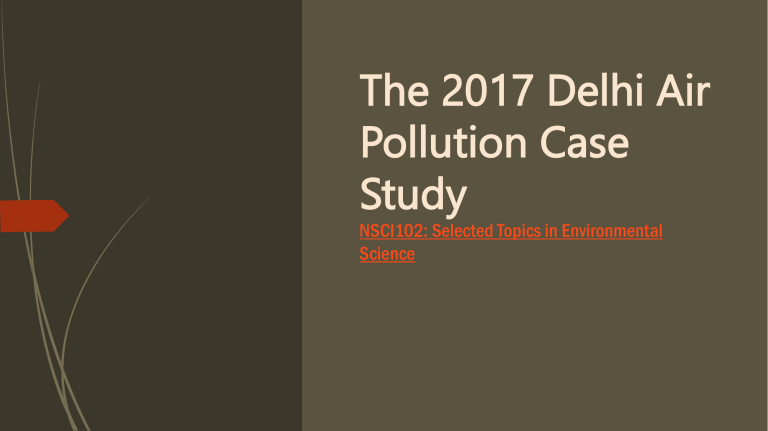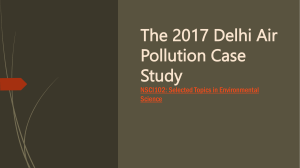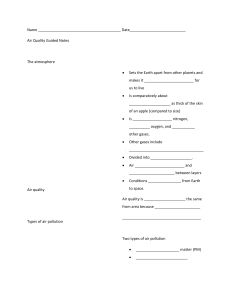Delhi Air Pollution Case Study 2017: Causes, Effects, Solutions
advertisement

The 2017 Delhi Air Pollution Case Study NSCI102: Selected Topics in Environmental Science By Kerillos Adel 18100607 Pierre Nabil 18200112 Presented to Dr Ayat Ossama Ghallab What is air pollution Air pollution occurs when harmful substances including particulates and biological molecules enters the atmosphere. It Causes acid rain , ozone depletion , photochemical smog, and other such phenomena. It may cause diseases, allergies or death in humans; it may also cause harm to other living organisms such as animals and food crops, and may damage the natural or built environment There are two major pollutants Primary pollutants (from direct process) Carbon dioxide, Sulphur dioxide and nitrogen dioxide •Secondary pollutants (from indirect process) Ground level ozone and SMOG First the Primary pollutants Sulphur dioxide Produced by volcanoes and in various industrial processes Coal and petroleum also contain Sulphur compounds And their combustion generates Sulphur dioxide Carbon dioxide CO2 is currently about 405 parts per million in earth's atmosphere, billions of metric tons of CO2 are emitted annually by burning of fossil fuels. Nitrogen dioxide Produced by volcanoes and in various industrial processes Coal and petroleum also contain Sulphur compounds And their combustion generates Sulphur dioxide then the secondary pollutants Ground Level Ozone • Ground level Ozone - 03 is formed from NO, and VOCs. It is largely emitted due to the combustion of fossil fuel. it is also a constituent of smog. • Peroxyacetyl nitrate - C2H3NO, is formed from NO, and VOCs. then the secondary pollutants SMOG Smog - It results from large amounts of coal burning in an area caused by a mixture of smoke and SO,. It also comes from vehicular and industrial emissions that are acted on in the atmosphere by ultraviolet light from the sun to form secondary pollutants that also combine with the primary emissions to form photochemical smog. Air Quality Index Parameters 101-200 moderate 301-400 very poor 401-500 severe 500+ hazardous The 2017 Delhi Air Pollution Case Study On November 8, 2017, the Air Quality Index crossed the pollution levels of 999, making it the worst of all. November 2017 is referred to as the Great Smog of Delhi as well because the air particulate hit the worst level, beyond the safe limit of 100. In India, air pollution is referred to as the silent and fifth largest killer in India. According to the WHO, the country has the highest death rate from asthma and chronic respiratory ailments in the world, as air pollution does irreversible lung damage to more than 50 per cent of children Identified the following pollutants in Delhi air: Vehicular emissions: 41 per % Dust: 21.5 per % Industries: 18 per % Other than vehicles, the great Delhi pollution is also caused by animal agriculture or stubble burning. Agriculture is the main occupation in adjacent states of Delhi. The farmers burn their crops to prepare it for next harvest, and the smoke makes way to Delhi, engulfing it in the thick layer of smoke. The air quality, which is already in the worse shape, gets terrible real quickly. Main factors caused for Delhi pollution Vehicular emissions (cars, 2wheelers ,trucks) Agricultural activates Exhaust from factories and industries Mining operations Indoor air pollution The effects on health Short term effects • Irritation to the eyes, nose and throat • Respiratory infections such as bronchitis • Pneumonia • Headaches • Nausea • Allergic reactions. •can aggravate the medical conditions of individuals with asthma and emphysema. The effects on health Long term effects • Chronic respiratory diseases • Lung cancer • Heart disease • Damage to the brain, nerves, liver, or kidneys. • Continual exposure to air pollution affects the lungs of growing children and may aggravate or complicate medical conditions in the elderly. • Pre-mature Deaths What happened next The Delhi government ordered Closure of 5000 school for 3 days Stopped all construction activities Shut down Badarpur thermal power station for 10days Solutions Use the Public Mode of Transportation Better Household Practices Conserve energy Understand the Concept of Reduce, Reuse and Recycle Emphasis on Clean Energy Resources Use Energy-Efficient Devices A healthy baby girl born in Delhi is Indraprastha apollo hospital on oct 29 kept in hospital for 2 days cause of Diwali how ever the baby have breathing trouble doctor said baby have perfectly developed lungs . When she was born about to suffer from bronchitis for life cause the pm2.5 reached on November 5 and 6 837ug/m3 and the safe limit is 60ug/m3 According to the central pollution control board (CPCB),on November 5 ,pm 2.5levels reached 999 at Punjabi Bagh and Anand Vihara . This is the maximum possible level most monitoring machines in the city are equipped to measure 150to 200 patients daily around this time of the year Most of them children as their immune system and their lungs not fully developed Thank you






